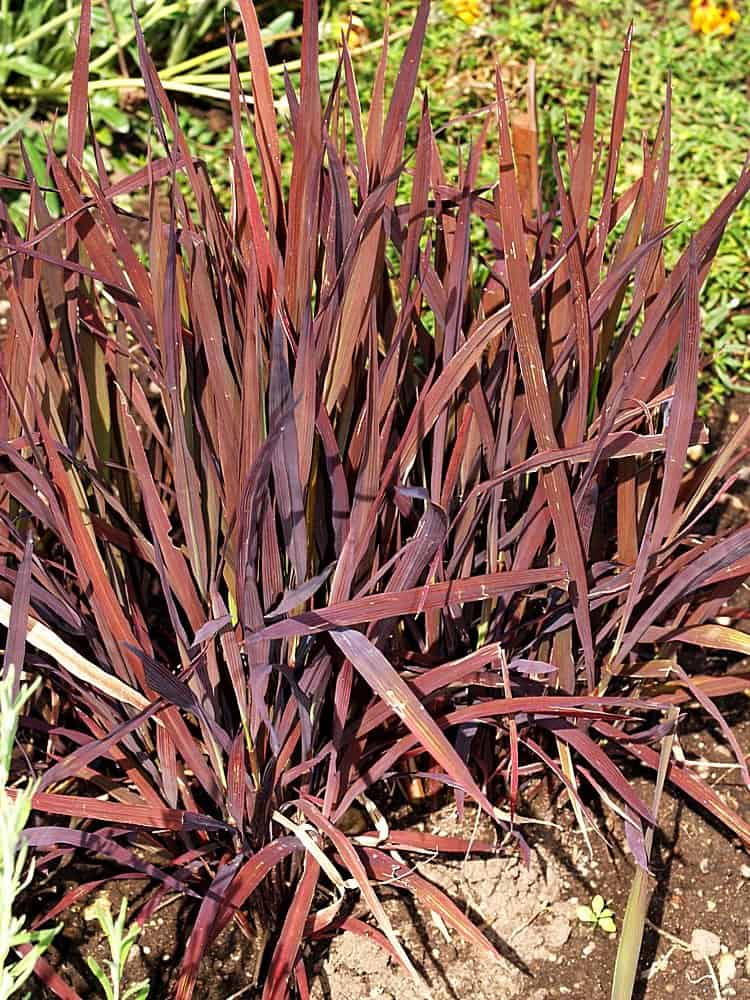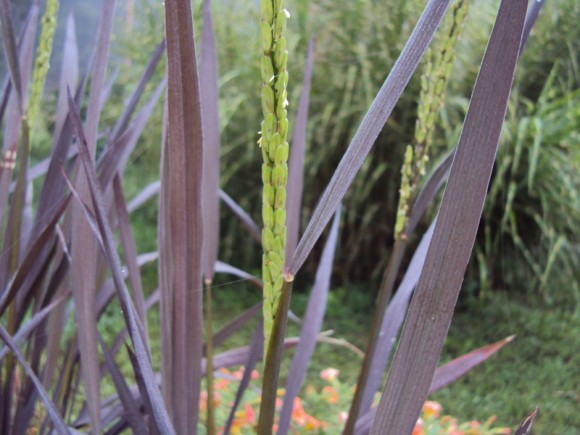I returned late Thursday night from the International Trials Conference at Longwood Gardens., and let me tell you—it was a fantastic trip. Not just because of the wealth of information shared, but because of the people I met, the new plants I saw, and the ever-growing list of things I now want to try in the gardens at Coastal Maine Botanical Gardens.
At the very top of my must-grow list for the coming year? The stunning, black-foliaged ornamental rice—Oryza sativa ‘Black Madras.’
A Bold Planting at Longwood
One of the standout plantings at the Longwood Gardens annual trials featured a mass of Black Madras rice, strategically placed in front of the deep, almost inky leaves of Pennisetum ‘Vertigo.’ This combination alone was dramatic, but the designers took it further by adding a yellow celosia and a pale-leaved Alternanthera along the edges, creating a vibrant contrast that made the entire bed look like a painter’s composition—bold, dynamic, and full of texture.

More Than Just an Ornamental
One of the surprises of seeing Black Madras rice in person was its seed production. While primarily grown for its striking deep burgundy to nearly black foliage, this plant still produces chartreuse-green rice kernels—a beautiful visual contrast against its dark leaves and flower stalks. The grains themselves aren’t necessarily grown for eating in large quantities, but in theory, they could be harvested.
When most of us think of rice, we picture flooded paddies and wetland agriculture, but seeing Oryza sativa ‘Black Madras’ thriving in a regular, well-amended garden bed at Longwood made me rethink how this plant could be used.
How to Grow Black Madras Rice
If you’re intrigued by the idea of adding a dramatic, edible-adjacent annual to your garden, here’s what I’ve learned about growing Black Madras:
- Sun & Soil: Like all rice, it thrives in full sun—the more, the better. It prefers rich, well-draining soil that retains moisture, so amending with compost is ideal.
- Water Needs: While it can be grown in a flooded paddy or aquatic planter (which could be a fun experiment), it doesn’t require standing water. As long as the soil stays consistently moist, it will grow just fine in a standard garden bed.
- Planting Methods: It can be grown from annual plugs or started from seed.
- Sowing Timeline – If starting from seed, you have two options:
- Late winter: Start indoors in flats, much like you would with tomatoes or peppers, then transplant outdoors when the soil warms.
- Late spring: Direct sow into the garden once all risk of frost has passed.
- Growth Habit: Black Madras grows to about 2-3 feet tall, forming a striking upright clump that adds movement and texture to plantings.
Creative Uses in the Garden
This is a plant with serious design potential. While its natural inclination might be as a bold focal point in mixed borders, I’m also thinking about some other interesting ways to experiment with it:
- Aquatic Planters & Water Gardens: Since rice thrives in moisture, Black Madras could be a great candidate for a water container garden, perhaps paired with lotus (Nelumbo), cannas, or water-loving sedges.
- Tropical & Exotic Borders: The rich, dark foliage could work beautifully alongside bananas (Musa), elephant ears (Colocasia), and canna lilies.
- Contrasting Color Palettes: Pairing Black Madras with bright golds, silvers, or chartreuse foliage plants (like Coleus, Heuchera, or even Zinnias) would amplify the depth of its color.
- Seasonal Interest in Containers: Imagine it in a large patio container with contrasting foliage like Pennisetum ‘Fireworks’ and Ipomoea batatas ‘Marguerite.’
Will We Get to Harvest Our Own Rice?
Here in Maine, our annuals don’t go into the ground until early June, so we’ll likely start Black Madras from seed in late winter. My goal is simply to see how it performs in our garden, but part of me wonders if we could actually get it to produce a small rice harvest.
Wouldn’t it be fun to collect a tiny batch of “micro-harvested” rice and serve it at the garden’s café? A single meal’s worth might be a stretch, but hey—it’s worth a shot!
Have You Grown Black Madras Rice?
I’m curious—have any of you tried growing Black Madras before? Did you grow it as an ornamental, or did you attempt a harvest? What did you pair it with in your garden?
Let’s talk rice—because this is one plant I can’t wait to experiment with.
–Rodney
Photos: botanickateplice.cz, davesgarden.com

+comments+